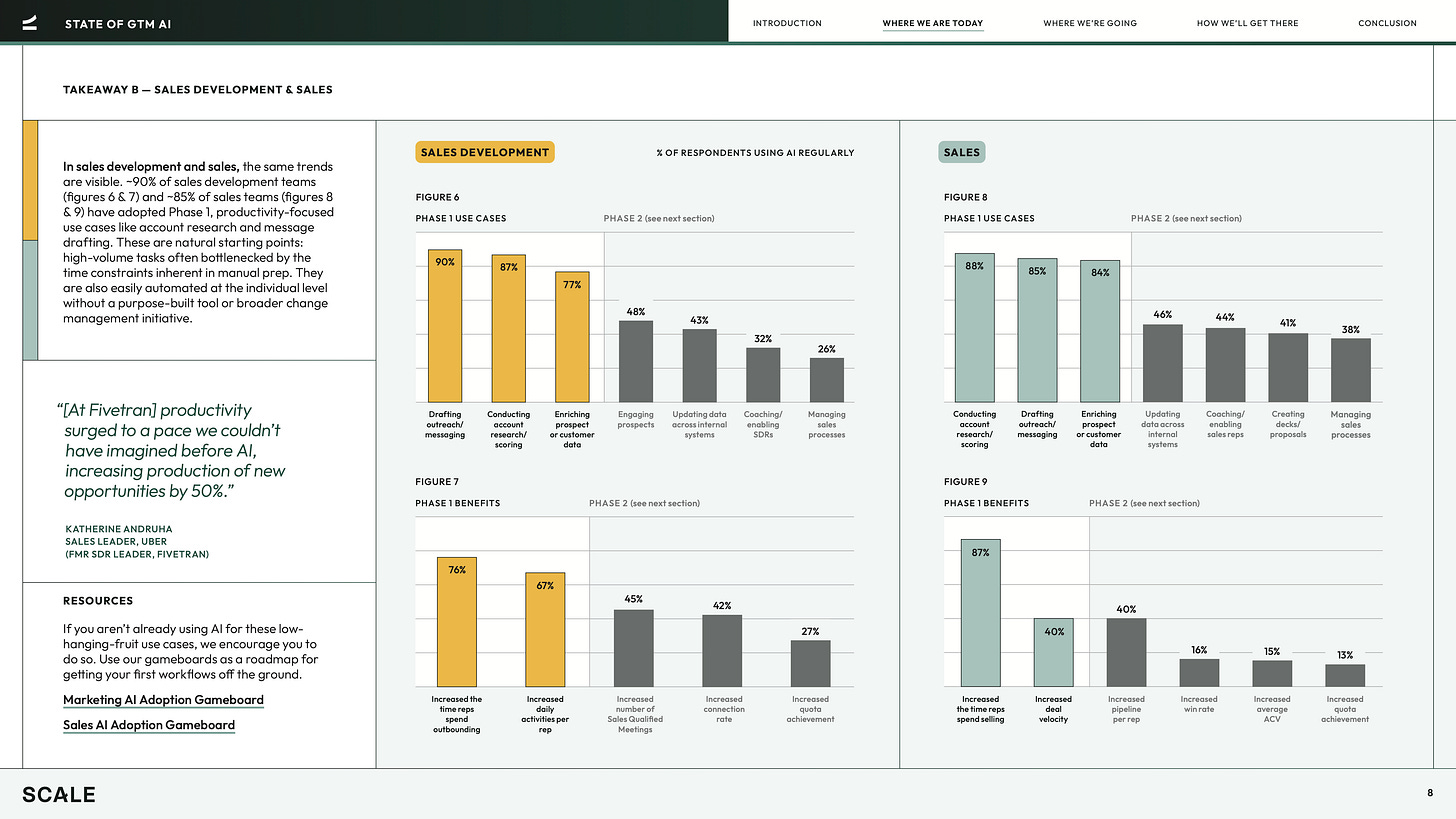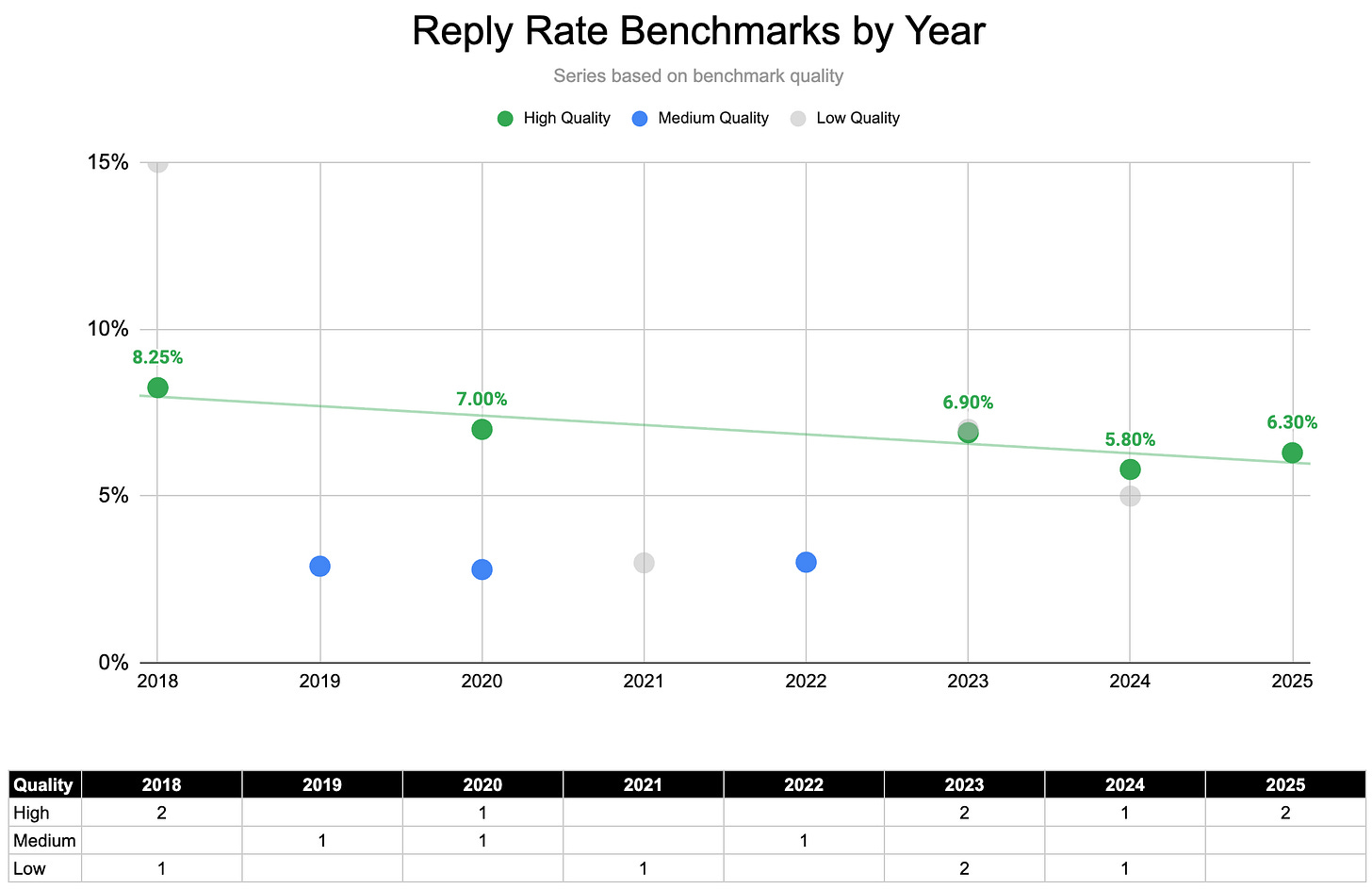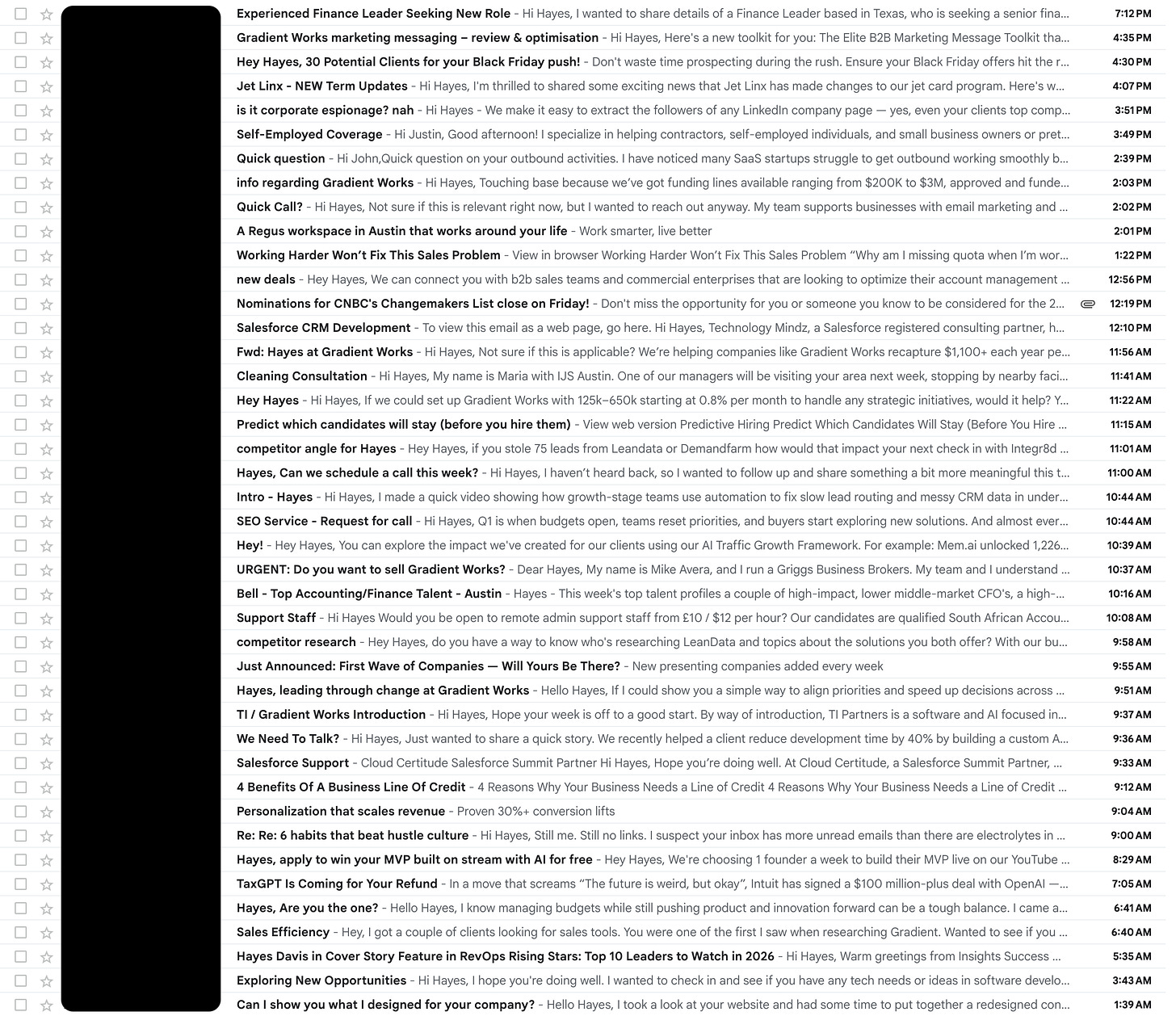The Cold Email Conundrum
Today's GTM AI use cases rely on email. Email is hard.
On Tuesday nights, I take my 9-year-old daughter to gymnastics. That gives me approximately 45 minutes surrounded by gymnastics trophies and a faint haze of chalk dust to ponder what the hell I’m going to write about in this newsletter.
This week I used the time to read the State of GTM AI in 2025 report from Scale Venture Partners. One thing I appreciated was that they asked respondents about specific use cases for specific roles, not just about nebulous “AI adoption”.
When I got to slide 8, I saw that 90% of sales dev teams and 85% of sales teams use AI regularly to draft their outreach. You can see the slide below:

Earlier this year, when I wrote about my conversion to the idea of the 10x sales rep, I mentioned that, for AI to be effective at scaling outbound activity, it would need to use multiple channels like phone, LinkedIn and email. Since cold calling with AI is generally illegal, all this AI message drafting has to be applied to LinkedIn or email.
That means we’re rapidly reaching a point where nearly all the text-based outbound buyers receive is AI-generated. That doesn’t automatically mean there’s no human in the loop—Scale’s data says 52% of SDR teams don’t (yet) routinely “engage prospects” using AI—but it sure looks inevitable that AI will both write and send the outreach for the vast majority of outbound.
Most of this outbound outreach will be email. Unlike LinkedIn, email is totally ubiquitous and easy to scale. That leads to the fundamental problem I wrote about in the 10x Sales Rep:
Because of the limits on other kinds of outreach, AI SDRs usually use mass email which is both legally suspect and has horrible conversion rates. Even assuming you somehow managed a 1% opportunity creation rate via that kind of email, you’d need your AI to work 100,000 accounts to get to the number of opportunities needed to produce pipeline to support a $10M quota. Your whole TAM may not be that large.
Those problems clearly haven’t stopped folks from trying. Spend enough time in the wrong corners of LinkedIn and you’ll learn all the tips and tricks about how to load up your AI-driven spam cannons. Soon you’ll find yourself in the gray area of disposable domains and inbox warming. Or you’ll realize that for the low price of 5 Clay tables, 18 SaaS products, API access to 3 LLMs, and 7 n8n workflows you too can book 200 meetings per month without an SDR team. (All you have to do is comment AGENT on this post and be ok with a 75% no-show rate!)
On the other side of the equation, you have some folks like Will Allred at Lavender who genuinely seem to be trying to use AI to help actual humans write really awesome emails to other humans.
In the end, no amount of AI-driven emailing is going to matter if email as a channel is already totally trashed. It sure feels trashed. I doubt I’m atypical and here’s what I’ve received just today:
These are all bad. But even if a good one snuck in, there’s so much bad here it would be really hard for it to get any attention. Suffice it to say none of these got a reply.
This is why the overall narrative (which I bought into in my 10x Sales Rep post) is that cold email used to work back in the halcyon pre-COVID days but now it doesn’t. There’s just too much noise now to drive meaningful response rates. Therefore, one of the most heavily adopted AI use cases—writing and sending email—isn’t actually helping us sell anything.
Is it actually harder to write email in 2025?
All of the above was going through my head as I was driving my daughter home from gymnastics. On the way, I told her that I still wasn’t sure what to write for my newsletter. Knowing this is an email newsletter, she replied (sarcastically), “Why don’t you write about how hard it is to write an email?”
Well the joke’s on her (and, it seems, me) because I decided to do just that. I realized I didn’t have solid data on whether the “decline of email” narrative was actually true. So, like I did in my post about outbound sequence benchmarks, I set out to scour the internet—this time with the goal of finding data points on reply rates1 for cold B2B email.
I identified 16 sources with statistics going back to 2018. Of those, I deemed 11 to be at least medium-to-high quality. High quality sources contained original research2 across a large corpus of emails. Medium quality sources were at least from reputable vendors.
Without further ado, here’s what I learned:

First, all those numbers are higher than I expected. They’re also higher than my personal experience. Let’s set that aside and look at the trend.
If we focus on just high quality sources, there’s a downward trend in reply rates, from 8.25% in 2018 to 6.3% in 2025. That 1.95 point drop represents a 23% drop in reply rates. If you use the 2024 data point of 5.8%, it’s a 30% drop.
So is it harder to write an email in 2025? Seems that way. It’s reasonable to say that it’s about 25% harder to write an email that gets a reply now than it was 7 years ago.
Email bulls and bears
Let’s review. About 90% of our SDR and sales teams are using AI in a way that depends on email for success. However, reply rates are 25% lower now than they were pre-COVID and they’re trending down.
Where do we go from here?
The bear case is an email death spiral. Declining reply rates combine with the declining marginal cost of writing email to spur teams to send even more email. That further clogs inboxes, causing reply rates to decline further and teams to send more email… You get the idea. No amount of AI makes any difference because nobody even bothers to read their email.
The bull case is that AI actually leads to better emails, not just more emails. It’s not crazy. I love SDRs, but the average SDR rarely has the training, time and inclination to compose truly relevant emails. At best they do some variable replacement and tweak a sentence in a stock template. (If you don’t believe me, just look at that screenshot from my inbox again.)
AI, on the other hand, could pull together all the context necessary to create carefully crafted messages on a per-recipient basis. With the right data, guidance and thoughtful messaging frameworks, AI might be able to write more truly great emails than most SDRs.
Which case are you buying?
I opted for reply rates because open rates are basically meaningless and click through rates are more of a marketing email thing.
This isn’t science (or Science) so there’s no peer review here. Most of these are vendors using propriety data sets. I suppose these folks could be lying through their teeth but there’s not much incentive to do that.



